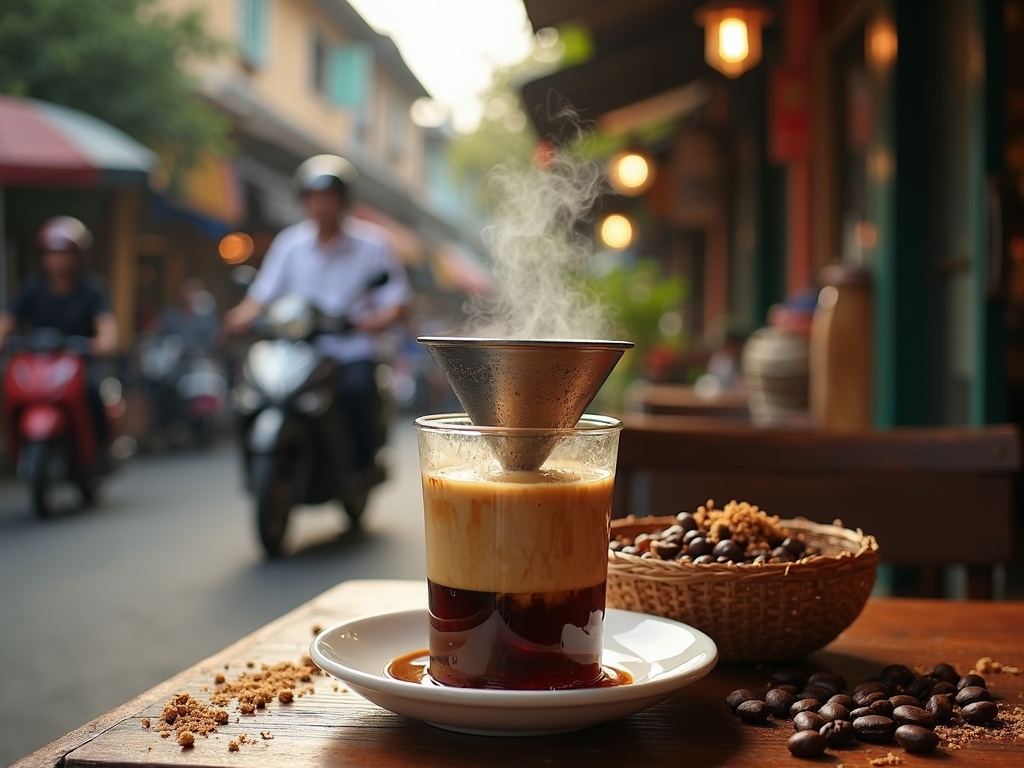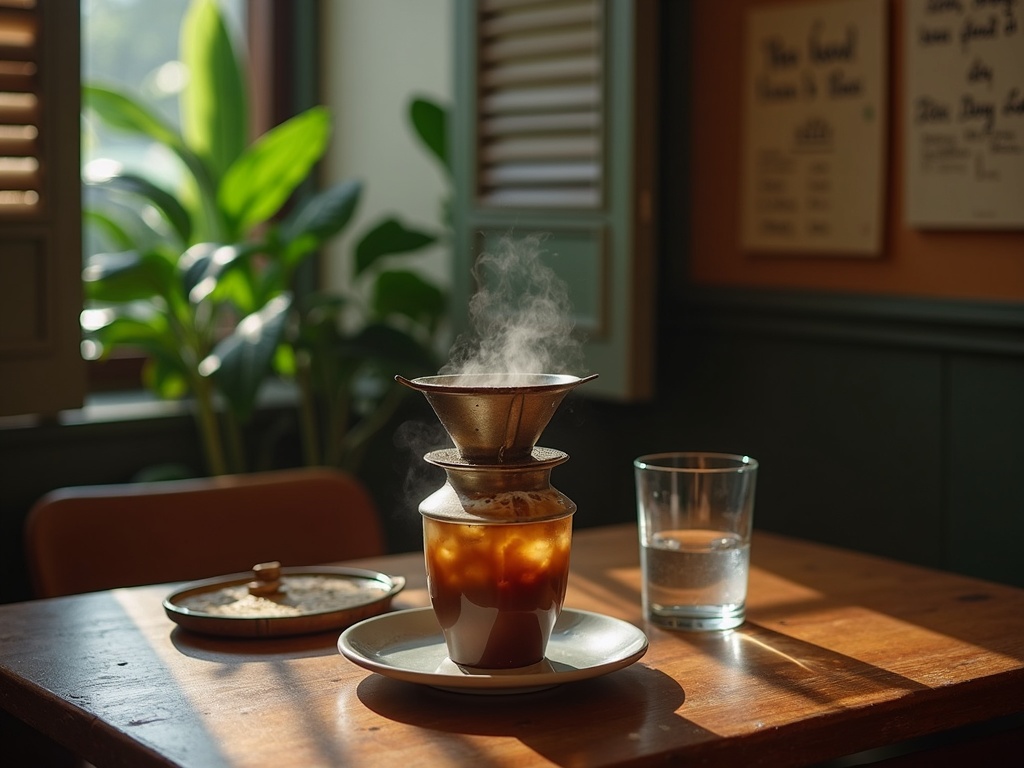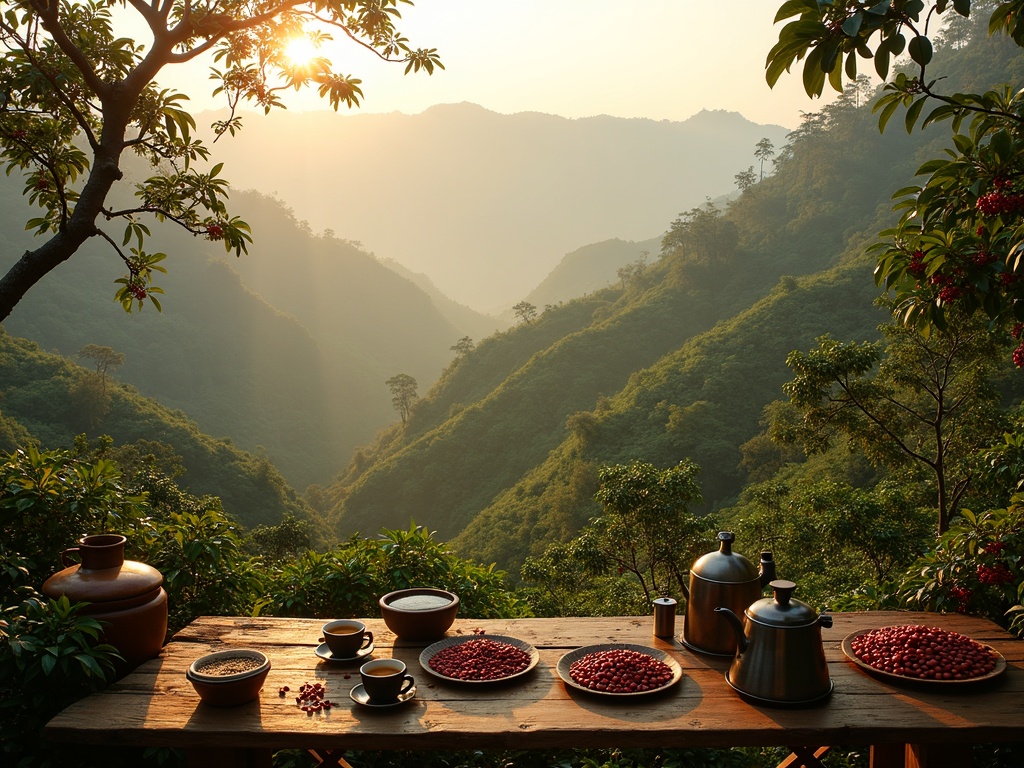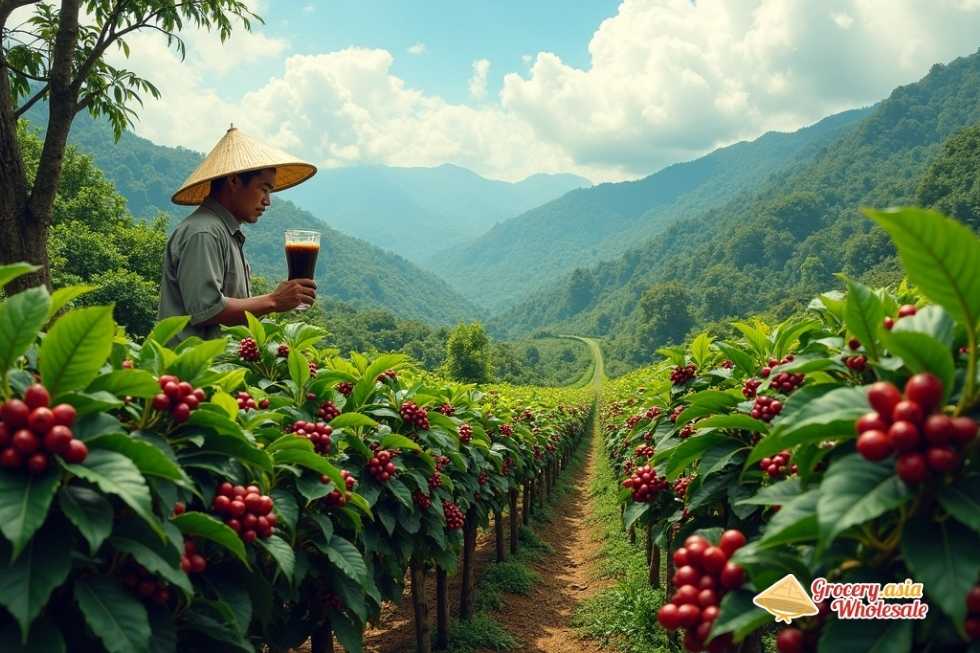No products in the cart.
Beverages News, Coffee
Is Vietnam Coffee Good What To Expect
Vietnamese coffee creates an exceptionally bold and distinctive experience built around high-caffeine Robusta beans that deliver twice the strength of typical Arabica varieties. This country’s coffee culture blends French colonial brewing influences with local innovations, establishing unique preparation methods using traditional phin filters and sweetened condensed milk that balance intense, earthy flavors with creamy sweetness.
Table of Contents
Key Takeaways
- Vietnamese coffee relies heavily on Robusta beans (95% of production), providing significantly higher caffeine content and a bold, earthy flavor profile with chocolatey and nutty undertones.
- Traditional brewing employs a phin filter system that produces concentrated, espresso-strength coffee through a slow 4–5 minute drip process, typically served over ice with sweetened condensed milk.
- Classic drinks include Cà Phê Sữa Đá, Cà Phê Trứng, and Cà Phê Đen Đá, each highlighting different aspects of Vietnamese coffee culture.
- Vietnam ranks as the globe’s second-largest coffee producer and leading Robusta supplier, with the Central Highlands region providing ideal growing conditions for consistent, high-quality beans.
- An emerging specialty coffee scene in high-altitude areas like Da Lat is producing premium Arabica varieties with fruity, acidic profiles that represent Vietnam’s evolution into diverse, quality-focused coffee production.
Vietnam: A Global Coffee Powerhouse
Vietnam stands as a formidable force in the global coffee industry, ranking as the world’s second-largest coffee producer after Brazil. I’ve observed how this Southeast Asian nation has transformed into a coffee giant over the past few decades, establishing its dominance through strategic cultivation practices and favorable growing conditions.
Robusta Bean Leadership
The country holds the distinction of being the number one global supplier of Robusta beans, a position that highlights Vietnam’s specialized expertise in this particular coffee variety. In the 2022/2023 season, Vietnam produced an impressive 29.75 million 60-kg bags, equivalent to 1.78 million metric tons of coffee. This massive output demonstrates the country’s capacity to meet global demand consistently.
Over 95% of Vietnam’s coffee output consists of Robusta beans, making it the world’s go-to source for this variety. This concentration allows Vietnamese farmers and exporters to refine their techniques specifically for Robusta cultivation, resulting in beans that meet international quality standards. Vietnamese coffee quality has earned recognition across global markets, with many international buyers preferring Vietnamese Robusta for its consistency and distinct characteristics.
The Central Highlands Advantage
The Central Highlands region serves as Vietnam’s primary coffee-growing area, providing ideal conditions for Robusta cultivation. Buon Ma Thuot, often called Vietnam’s ‘coffee capital’, exemplifies the region’s commitment to coffee excellence. The area’s elevation, climate, and soil conditions create an environment where coffee plants thrive naturally.
Coffee exports represent a major share of Vietnam’s agricultural economy, contributing significantly to the country’s GDP and providing livelihoods for millions of farmers. The economic impact extends beyond direct farming, supporting:
- Processing facilities
- Transportation networks
- Export infrastructure
This integrated approach has helped Vietnam maintain its competitive position while ensuring sustainable growth in production capacity.
The scale of Vietnam’s coffee industry affects global pricing and availability, making the country an essential player in international coffee markets. When Vietnam experiences good harvests, global Robusta prices tend to stabilize, while production challenges can create ripple effects across the industry. This influence underscores Vietnam’s critical role in satisfying worldwide coffee consumption, particularly for instant coffee production and espresso blends where Robusta beans are preferred.
The Bold Character of Vietnamese Coffee: What to Expect
Vietnamese coffee delivers an experience unlike any other coffee tradition. I’ve found that understanding its unique characteristics helps coffee drinkers appreciate why millions of Vietnamese people start their day with this distinctive brew.
Robusta’s Powerful Foundation
Robusta beans form the backbone of Vietnamese coffee culture, accounting for nearly 95% of the country’s production. These beans pack almost double the caffeine content of their Arabica counterparts, delivering a powerful energy boost that’ll keep you alert for hours. When you sip Vietnamese coffee, you’re experiencing one of the strongest natural coffee preparations available.
The flavor profile strikes many newcomers as bold and earthy, with distinct chocolatey undertones that develop during the roasting process. I often notice nutty notes in premium Vietnamese blends, though some varieties can exhibit a slightly rubbery characteristic that’s actually prized by local coffee enthusiasts. This unique taste signature comes from Robusta’s natural flavor compounds, which differ significantly from the fruity or floral notes found in Arabica varieties.
Dark Roast Tradition and Brewing Heritage
Vietnam’s dark roast tradition creates an intense, often bitter taste that perfectly complements the country’s signature brewing methods. French colonial influence shaped this roasting style during the 19th century, establishing preferences that continue today. The French introduced espresso-style brewing techniques, which Vietnamese coffee makers adapted to work with local Robusta beans and available equipment.
I’ve observed that Vietnamese coffee culture emphasizes low acidity and strong body as signature characteristics. This combination produces a coffee that feels substantial in your mouth, with a lingering finish that doesn’t assault your palate with sharp acidic notes. The brewing process using traditional phin filters extracts maximum flavor while maintaining these desired qualities.
The dark roasting process caramelizes the bean’s natural sugars, contributing to those chocolatey flavors while reducing any bright, acidic notes that might compete with the coffee’s inherent boldness. French influence also introduced the practice of adding sweetened condensed milk, which balances the intensity and creates the beloved cà phê sữa đá.
Vietnamese coffee makers have perfected techniques that highlight Robusta’s strengths while minimizing any harsh qualities. Local brewing methods involve slow extraction times that allow full flavor development without over-extraction. This careful approach explains why Vietnamese coffee maintains its reputation for strength without becoming undrinkably bitter.
Modern Vietnamese coffee retains these colonial influences while incorporating local innovations. Roasters often blend different Robusta varieties from various regions, creating complex flavor profiles that showcase Vietnam’s diverse growing conditions. Highland regions produce beans with more subtle characteristics, while lowland varieties contribute to the bold, earthy foundation.
The preparation ritual itself reflects this heritage. Traditional Vietnamese filters require patience and attention, encouraging a mindful approach to coffee consumption that honors both French café culture and Vietnamese respect for quality ingredients.
Understanding Vietnamese coffee’s character helps explain why it’s gained international recognition. Vietnam’s coffee quality continues improving as producers focus on sustainable farming practices and careful processing techniques. The result is a coffee experience that’s both powerful and sophisticated, offering depth that keeps coffee enthusiasts coming back for more.
Whether you’re trying Vietnamese coffee for the first time or deepening your appreciation for this unique tradition, expect a bold, full-bodied experience that showcases Robusta beans at their finest. The combination of high caffeine content, rich flavor, and cultural heritage creates a coffee drinking experience that’s distinctly Vietnamese yet increasingly appreciated worldwide.

The Traditional Vietnamese Coffee Experience
The traditional Vietnamese coffee experience centers around a perfect marriage of strong Robusta beans and sweetened condensed milk that creates an unforgettable flavor profile. I’ve discovered that this combination isn’t just about taste—it’s a culinary solution born from historical necessity that has become the heart of Vietnamese coffee culture.
Sweetened condensed milk serves as the ideal counterbalance to Robusta’s naturally intense and slightly bitter characteristics. During French Indochina, fresh milk was scarce and difficult to preserve in the tropical climate, making condensed milk a practical alternative that French colonists and Vietnamese locals embraced. This historical adaptation transformed into a defining feature that makes Vietnamese coffee distinct from other global coffee traditions.
The Phin Filter Brewing Method
The brewing process relies on the phin, a small metal drip filter that produces remarkably concentrated coffee. I find that using a Vietnam coffee filter creates coffee with strength comparable to espresso, yet with its own unique character. The phin’s simple design—a perforated metal chamber with a fitted press plate—allows hot water to slowly extract maximum flavor from the grounds.
Brewing takes between 4 and 5 minutes, creating a deliberate ritual that encourages patience and mindfulness. During this time, I watch as dark drops slowly emerge from the filter, building anticipation for that first sip. This measured pace contrasts sharply with modern coffee culture’s emphasis on speed and convenience.
The result is thick, bold coffee that delivers an intense caffeine experience. Vietnamese coffee’s strength often surprises first-time drinkers who expect something milder. The concentrated brew typically gets served over ice, creating ca phe sua da—iced coffee with condensed milk—that provides refreshing relief from Vietnam’s humid climate.
I appreciate how this traditional preparation method honors both the coffee’s natural intensity and the drinker’s need for a moment of calm reflection. The phin filter doesn’t just brew coffee; it creates an experience that connects modern coffee lovers with generations of Vietnamese tradition. Each cup represents a balance between French colonial influence and Vietnamese ingenuity, resulting in something entirely unique that stands apart from other global coffee preparations.

Must-Try Vietnamese Coffee Drinks
Vietnamese coffee culture has produced some truly exceptional beverages that showcase the country’s unique approach to brewing. Each drink offers a distinct flavor profile that highlights the bold character of Vietnamese coffee beans.
Classic Vietnamese Coffee Staples
I recommend starting with Cà Phê Sữa Đá, Vietnam’s most iconic coffee drink. This iced coffee with condensed milk creates the perfect balance between bitter coffee and sweet, creamy milk. The slow drip brewing method through a traditional phin filter allows the flavors to develop fully, resulting in a rich and satisfying beverage that has become synonymous with Vietnamese coffee culture.
For those who prefer their coffee without sweetness, Cà Phê Đen Đá delivers a powerful punch. This iced black coffee showcases the natural strength and bold flavors of Vietnamese beans. I find this drink particularly refreshing during hot weather, as it provides pure coffee intensity without any additives to mask the bean’s authentic taste.
Cà Phê Trứng represents one of Vietnam’s most innovative coffee creations. Invented in Hanoi during the 1940s, this egg coffee features a luxurious topping made from whipped egg yolk and condensed milk cream. The result is an incredibly rich, dessert-like beverage that transforms your typical coffee experience into something extraordinary.
Modern Vietnamese Coffee Variations
Cà Phê Cốt Dừa brings tropical flavors into your coffee cup through its blend of coffee, coconut cream, and condensed milk. This drink offers a smoother, more exotic taste profile that appeals to those who enjoy creamy beverages with a hint of coconut sweetness.
Bạc Xỉu takes a different approach by emphasizing milk over coffee. This milk-forward drink contains just a shot of strong Vietnamese brew, creating a lighter taste that’s perfect for those who want to experience Vietnamese coffee without the intense caffeine kick. I suggest this option for afternoon sipping or for coffee newcomers who want to ease into the strong Vietnamese coffee tradition.
Each of these drinks can be prepared using traditional Vietnamese brewing methods with a phin filter. The slow extraction process enhances the coffee’s natural oils and creates the distinctive flavor profile that makes Vietnamese coffee stand out globally.
How to Brew Vietnamese Coffee Like a Local
I’ve discovered that mastering the phin filter technique transforms an ordinary coffee experience into something truly authentic. The traditional Vietnamese brewing method produces a distinctly rich and concentrated cup that stands apart from standard Western preparations.
Essential Brewing Steps
The process begins with measuring 2-3 tablespoons of coarse-ground coffee into the phin chamber. I recommend using a slightly coarser grind than what you’d typically use for drip coffee, as this prevents over-extraction and allows proper water flow through the filter.
Next, I place the filter press gently on top of the grounds without applying excessive pressure. Too much force compacts the coffee and slows the brewing process unnecessarily. Position your assembled phin directly over a glass, adding a tablespoon or two of sweetened condensed milk if you prefer the traditional cà phê sữa style.
The blooming stage requires patience and precision. I pour just enough hot water (around 200°F) to saturate the grounds, then wait 30 seconds for the coffee to bloom and release its aromatic compounds. After blooming, I fill the chamber completely with hot water and place the lid on top to retain heat.
Timing and Serving Traditions
Allow 4-5 minutes for the coffee to drip slowly through the filter. This extended brewing time extracts maximum flavor and creates the signature intensity that makes Vietnamese coffee culture so distinctive. I’ve learned that rushing this process compromises the final result.
While you can certainly enjoy the coffee hot, most locals serve it over ice, especially during Vietnam’s warm climate. The contrast between the hot, concentrated coffee and cold ice creates a refreshing drink that’s perfect for any time of day. This iced preparation has become synonymous with authentic Vietnamese coffee service.
The brewing ratio used in Vietnamese preparation is considerably stronger than typical Western methods. Where standard drip coffee might use a 1:15 or 1:17 ratio, Vietnamese coffee employs roughly a 1:8 to 1:10 ratio, yielding that characteristic rich, concentrated flavor profile. This intensity explains why Vietnamese coffee is strong compared to most international varieties.
I find that proper Vietnam coffee filter usage requires practice to achieve consistent results. The key lies in maintaining steady water temperature and avoiding the temptation to press down on the filter during brewing. Each cup should take roughly the same amount of time to brew when you’ve found your optimal technique.
Temperature control plays a crucial role in extraction. Water that’s too hot burns the coffee, while water that’s too cool under-extracts essential oils and flavors. I maintain water temperature between 195-205°F throughout the brewing process for optimal results.
The final product showcases why Vietnam has earned recognition for producing exceptional coffee. When brewed correctly using traditional methods, Vietnamese coffee delivers a bold, smooth cup with minimal bitterness despite its strength. The slow drip process allows for even extraction while the fine balance of oils and acids creates depth without overwhelming intensity.
This traditional approach demonstrates how locals make Vietnamese coffee with such consistency and quality. Each step serves a specific purpose in developing the complex flavor profile that has made Vietnamese coffee internationally recognized and appreciated by coffee enthusiasts worldwide.
Beyond Tradition: Vietnam’s Emerging Specialty Coffee Scene
Vietnam’s coffee landscape extends far beyond the bold, traditional Robusta beans that built its reputation. I’ve witnessed a fascinating transformation as specialty Arabica cultivation takes root in Da Lat, Lam Dong Province, where high-altitude conditions create opportunities for entirely different coffee experiences.
High-Altitude Arabica Revolution
The 1,500-meter elevation in Da Lat provides the perfect climate for growing delicate Arabica varieties that produce fruity, acidic flavor profiles. This high-altitude environment allows coffee plants to develop slowly, concentrating flavors that differ dramatically from the earthy, bitter notes associated with Vietnamese coffee culture. These specialty beans showcase Vietnam’s potential to compete in premium coffee markets rather than just volume production.
I find it remarkable how these mountain-grown Arabicas demonstrate the country’s diverse terroir. The cooler temperatures and specific soil conditions in Lam Dong Province create beans that express bright acidity and complex fruit notes – characteristics typically associated with renowned coffee regions like Ethiopia or Colombia. This development proves that Vietnam coffee quality can match international standards when grown under optimal conditions.
Third-Wave Coffee Culture Emerges
Ho Chi Minh City and Hanoi now feature specialty cafes that embrace third-wave coffee principles, offering pour-over, siphon, and Aeropress brewing methods. These establishments focus on highlighting the unique characteristics of Vietnamese-grown Arabica beans rather than masking them with condensed milk or sugar. I’ve observed how these cafes educate customers about origin, processing methods, and brewing techniques – a stark contrast to traditional coffee preparation.
The emergence of these specialty cafes represents more than just changing consumer preferences. They’re actively promoting Vietnamese-grown Arabica to local coffee drinkers who previously only experienced Robusta-based preparations. This educational approach helps expand appreciation for the diverse flavors possible within Vietnamese coffee production.
Specialty coffee shops increasingly source directly from Da Lat farms, creating transparent supply chains that benefit both producers and consumers. These relationships allow farmers to receive premium prices for their carefully cultivated Arabica crops while giving cafes access to traceable, high-quality beans. I notice this direct trade approach mirrors successful models from other specialty coffee origins worldwide.
Although specialty Arabica currently represents a small portion of Vietnam’s total coffee output, this segment points toward the industry’s future direction. The focus on quality over quantity aligns with global coffee trends where consumers increasingly value origin stories, processing methods, and flavor complexity. Vietnam’s specialty coffee scene demonstrates the country’s ability to adapt and evolve beyond its traditional Robusta dominance.
The shift toward specialty Arabica cultivation showcases Vietnam’s diverse terroir and elevates its position in the global specialty coffee market. These high-altitude farms produce beans that express unique Vietnamese characteristics while meeting international quality standards. The combination of favorable growing conditions and increasing expertise in processing creates opportunities for Vietnam to establish itself as a premium coffee origin.
I see this specialty movement as validation that Vietnamese coffee producers can excel across multiple market segments. While traditional Vietnamese coffee strength and distinctive preparation methods will always have their place, the emergence of specialty Arabica adds valuable diversity to the country’s coffee portfolio. This evolution positions Vietnam to capture both traditional and premium market segments as global coffee consumption continues growing.
The success of Da Lat’s specialty farms and urban third-wave cafes creates a foundation for further expansion throughout Vietnam’s coffee regions. As more producers experiment with Arabica cultivation and processing techniques, the country’s reputation for coffee excellence will likely extend well beyond its current association with strong, traditional preparations.

Sources:
USDA Foreign Agricultural Service, “Coffee: World Markets and Trade”
International Coffee Organization, “Trade Statistics Tables”
Perfect Daily Grind, “A Roaster’s Guide To Vietnamese Coffee”
Vietnam Coffee-Cocoa Association (VICOFA), “Coffee Export Report”
CNN Travel, “Hanoi’s Egg Coffee”


